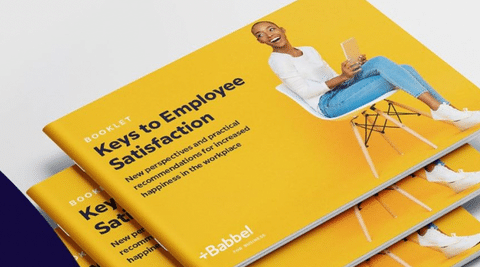In this post, we explore the benefits and potential drawbacks of flexible work arrangements. We also share practical steps you can follow to create a more flexible workplace.
Flexibility is fast becoming the number one factor people consider when weighing up their job prospects. And, with more employers offering flexible work arrangements, those who don’t will find themselves losing top talent — and struggling to replace them.
If you want to become or remain a competitive employer, it’s time to start thinking about flexible work.
We’ve covered everything you need to know in this guide. Keep reading to learn why flexibility matters and how you can successfully create a more flexible workplace.
Table of Contents
- What are flexible work arrangements?
- 5 popular types of flexible work arrangements
- The importance of flexibility in the workplace — why does it matter?
- 7 key benefits of providing flexible work arrangements
- What are the challenges and drawbacks of flexible work?
- How to offer more flexibility in the workplace (and make it work)
- Flexibility in the workplace: the takeaway

What are the keys to employee satisfaction?
Discover helpful tips to achieve employee happiness in our practical booklet “The Path to Employee Satisfaction.” Download it now for free!
What are flexible work arrangements?
Rather than a one-size-fits-all model where everybody has to be present in the office at the same time, flexible work accommodates employees’ individual needs, preferences, and availability. It’s about empowering people to work in a way that suits them while ensuring that business goals are met.
Workplace flexibility typically focuses on two key areas:
- schedule-based flexibility — when does the work get done?
- location-based flexibility — where does the work get done?
With that, let’s explore what workplace flexibility might look like in practice.
5 popular types of flexible work arrangements
Flexibility in the workplace can take many different forms. Among the most common types of flexible work arrangements are:
- Flexi time (or flexible working hours). Employees have some flexibility to determine their own schedules. For example, starting and finishing earlier/later or taking a few hours off in the afternoon and catching up another day.
- Remote work/working from home. Employees may be able to work from home all or some of the time, and/or remotely from other countries. Some companies offer fully remote policies while others operate a hybrid model.
- A condensed work week. This is another form of flexi time where employees can condense their working week into fewer days. For example, if the standard working week is 40 hours, employees may choose to work four 10-hour days rather than five 8-hour days.
- Four-day week. Research suggests that employees are just as productive — if not more so — in a four-day week, and that the fifth day is unnecessary. The four-day model effectively gets rid of the fifth working day, giving employees fewer working hours without reducing their workload or salary.
- Job sharing. Rather than one full-time employee for a given role, the role is split between two part-time employees. This affords the job-sharing employees the flexibility of a part-time role while the company still benefits from full-time presence and output.

The importance of flexibility in the workplace — why does it matter?
Workplace flexibility has a huge impact on the individual employee, the broader company culture and, ultimately, the overall success of the business.
When you embrace flexible working, you acknowledge that not all employees are the same — and you create an environment that caters to their differences. This kind of freedom and autonomy is critical to providing a positive employee experience (EX) which, in turn, has a major impact on employee engagement, performance, and retention.
An Atlassian study comparing employees with some location flexibility and those without found that, among those with location flexibility, 83% expressed a positive outlook on their organization’s company culture. Only 43% of those without location flexibility shared this positive outlook.
And flexibility isn’t just a nice-to-have. It’s quickly becoming something that workers expect and actively seek out when applying for jobs and making career decisions. This rings true across the board: according to a LiveCareer study, 76% of Millennials, 69% of Gen Z, and 64% of Gen X workers expect some degree of flexibility in the workplace.
Ultimately, allowing more flexibility is about empowering your employees to do their best work. It’s about evolving in line with employee expectations, creating an environment where everybody has a chance to thrive, developing a strong and attractive employer brand, and remaining adaptable in the ever-changing world of work.
Another great flexible work arrangement you could offer your employees is a workation. In episode 13 of our podcast, we talk about how workations are popular employee benefits that can help your employees feel less stressed and prevent burnout. Listen here:
7 key benefits of providing flexible work arrangements
In a Deloitte survey of over 1,000 US workers, 94% of respondents said they would benefit from flexible working arrangements. That’s a significant vote in favor of workplace flexibility!
So what exactly are the benefits? Flexible work can:
- Increase productivity and performance. Everyone is different. Some people are more productive in the morning; others spring into action later in the day. Some people work best in a sociable environment; others thrive with silence and focus. When you allow your employees to work in a way that suits them, you’re more likely to get them at their most productive.
- Boost innovation. According to an Atlassian study, 71% of workers with some location flexibility consider their team to be innovative, compared to just 57% of workers who have no flexibility.
- Reduce absenteeism. Absenteeism negatively impacts employee morale and productivity, and it’s extremely expensive. The CDC estimates that absenteeism costs employers over $225 billion each year in the United States (or around $1,685 per employee). With more flexibility, employees are less likely to take unscheduled time off. And, because flexibility boosts employee well-being (see the next benefit on our list), it helps to reduce illness-related absences.
- Boost employee well-being. With more workplace flexibility, employees can save their annual leave for rest and relaxation — meaning they can reap the health benefits of proper downtime. Flexible work is also proven to reduce burnout and stress, with just 14% of workers with location flexibility reporting burnout symptoms compared to 36% of workers who don’t have any flexibility (Atlassian).
- Create a better work-life balance. In a Future Forum study of 10,000 knowledge workers, location flexibility was associated with a 45% increase in work-life balance. A good work-life balance is crucial for keeping your employees happy, healthy, and engaged. You can learn more about how to create a healthy work-life balance for your employees (and why it matters) in this guide.
- Attract and retain top talent. Earlier on, we highlighted that the majority of workers across all generations expect some degree of flexibility at work. Flexible work arrangements will prove increasingly critical in attracting and retaining top talent in the competitive hiring landscape.
- Make you a more accessible and inclusive employer. Flexible work acknowledges that everybody is different. When you cater to different needs, schedules, preferences, and levels of availability, you create an environment where all different kinds of people can thrive. In doing so, you can build a workplace that’s accessible, inclusive, diverse, and equitable.
Those are the benefits. Now what about the less-than-desirable aspects of flexible work? Are there any? Let’s find out in the next section.
In other articles, you can learn more about the most desirable employee benefits and why Babbel is a great corporate benefit.
What are the challenges and drawbacks of flexible work?
Introducing flexible work is not without its challenges. Here are some potential drawbacks to keep in mind:
- Workers with location flexibility may be more prone to imposter syndrome. In a study exploring the impact of location flexibility on employee outcomes, workers with some flexibility exhibited more symptoms of imposter syndrome (42%) than their peers who don’t have any kind of workplace flexibility (30%). This may be the result of remote employees feeling like they have to work harder to prove themselves if they’re not visible and present in the office. You can learn how to recognize if your employees have imposter syndrome here.
- Some employees fear that working flexibly will hinder their professional growth. In a Deloitte survey of 1,000 US-based employees, 30% said that potential consequences to their professional development would prevent them from taking advantage of flexible work options. This indicates that there is still some stigma around flexible work, and that some employees may not feel able to embrace it for fear of being viewed unfavorably by their managers.
- Flexible work without clarity and trust is a recipe for disaster. There is so much to gain from flexible work, both for employers and employees alike, but only if the conditions are right. In organizations that lack trust, transparency, and clarity, introducing flexible work may do more harm than good. Some employees may not trust that they can work flexibly without negative consequences, while others may resent their teammates who do embrace flexible working. If you are considering more flexible work arrangements, make sure you have the right foundations in place for it to be a success.
Don’t let those potential challenges deter you. After all, there are many more benefits than drawbacks! With some careful planning and consideration, you can successfully introduce flexible work arrangements and reap the rewards.

How to offer more flexibility in the workplace (and make it work)
Want to embrace a more flexible way of work? Follow these three key steps:
- Find out what kind of flexibility your employees value most
- Factor in the challenges (and take measures to overcome them)
- Establish a flexible work arrangements policy — clarity is key!
1. Find out what kind of flexibility your employees value most
Workplace flexibility isn’t one-size-fits-all. It’s important to determine what kind of flexible work arrangements will provide the most value within your organization, as well as what’s feasible.
Ask your employees what flexibility means to them. In an ideal world, what would a flexible workplace look like? Given the choice, what flexible working arrangements would they prioritize?
You may not be able to fulfill everybody’s vision of the ideal flexible workplace, but you can use it as a starting point. Speak to your employees one on one (or have managers speak to their direct reports) and send out an anonymous company survey.
Once you’ve gauged what flexible work means to your employees and how it might look at your company, you can start to bring that vision to life.
2. Factor in the challenges (and take measures to overcome them)
The benefits of flexible work far outweigh the negatives, as we saw earlier. However, it’s still necessary to anticipate potential stumbling blocks and have measures in place to overcome them.
How might flexible work impact company-wide communication and meeting culture? What tools, measures, and practices can you bring in to foster communication among remote teams and/or people with different work schedules?
How will you ensure that everybody feels able to take advantage of flexible work? Will you commit to making sure that everybody has the opportunity to grow and progress, regardless of whether they choose to work flexibly or not?
It’s also worth asking your employees what concerns they have about flexible work (again, anonymous surveys work well here). That way, you can run a thorough risk assessment and be adequately prepared.
3. Establish a flexible work arrangements policy — clarity is key!
According to FlexJobs, 64% of companies offer flexible work arrangements without any kind of formal written policy.
But going flexible without a policy in place can lead to confusion, miscommunication, and uncertainty. Clarity is absolutely key here: it’s important that everybody knows what type of flexible work is available to them, as well as what’s expected of them.
If you’re introducing hybrid work, for example, are there certain days — or a certain number of days — where employees are expected to be in the office? Is there a specific process they need to follow if they want to work abroad for a week or two? If you’re introducing flexi-time, is it entirely flexible or does everybody need to start between, say, 8 and 11 am?
Set everything in writing, go through the policy with your employees, and make sure it’s readily accessible as a clear point of reference.
The more clarity you can provide, the easier it will be for you and your employees to embrace flexible work and all its benefits.
Flexibility in the workplace: the takeaway
If there’s anything we’ve learned in recent years, it’s that most employees can do great work without the traditional constraints in place. With more flexibility, we can build an adaptable, accessible, and inclusive workplace that works for everyone. Flexible work benefits company culture, employee morale, individual well-being, and business performance — what’s not to love?

What are the keys to employee satisfaction?
Discover helpful tips to achieve employee happiness in our practical booklet “The Path to Employee Satisfaction.” Download it now for free!







